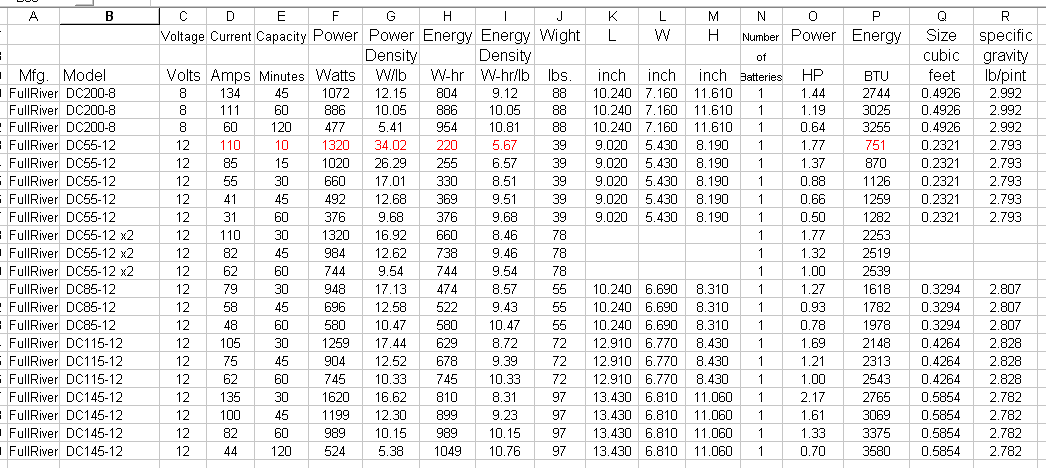http://EVAoSD.FarTooMuch.Info/evsim3.htm is this page's URL.
Simulation of an Electric Vehicle
Part 3 - Batteries
by J. Russell Lemon
February 2009
Battery Spread sheet
In order to evaluate the various trade-offs of different battery configurations, I have taken published battery information and put an few examples on a spread sheet. These parameters include battery name [A], model [B], weight [J], rated voltage [C], time to discharge [E] at a geven current, and that current [D]. From this data I calculate power [F] and power density at the rated current [G], and energy [H] and energy density [I] at that current. Power is also given in horsepower [O] and energy in BTU [P] for comparison with fosel fuels. Data came from Fullriver battery company, as published on the web on their Fullriver's technical page. Similiar data is available from Trojan battery company and from U. S. Battery. Before doing any design, be sure and download the latest technical information because batteries are always being improved and specs change.
Since small vehicle conversions require about 15 to 20 kW at 65 mph, it is obvious that actual power requirement is closer to a kilowatt per battery. This greatly reduces the time to discharge because the time to discharge decreases faster then power output increases. This non-linearity hits hardest during acceleration and climbing hills. Both require a significant increase in power.

Single Battery Table
Single Battery Table: [F] = [C] * [D], [G] = [F] / [J], [H] = [F] * [E] / 60, [I] = [H] / [J] [O] = [F] / 746, [P] = [H] / 3.413, [Q] = [K] * [L] * [M] / 1728, [R] = 28.875 * [K] * [[L] * [M] / [J]. [1 hp = 746 watts, 1 BTU = 3.413 W-hr, 1 pt = 28.875 cubic inches, 1 pt water is about 1 pound. (a pints a pound the world around) so specific gravity of water is one.] Note that in table 2, kilo = 1000. I used Microsoft's Excel, but Sun's Calc in Open Office does the same thing...and it's a free download.

Battery String Table
From the first tables on single batteries, I generated the second table to compare batteries strings. From these comparisons you can find that two parallel strings used individually, one after the other, will double range. But if these two parallel strings are used together, the range is more then doubled because of the non-linearity that says cutting a single batteries output current in half will more then double time of discharge.
For example: Suppose you need about 60A from a 144V battery pack to maintain speed. You find with your pack of 12 FR DC55-12 batteries, you do not have enough enery to complete your journey, so you add a second battery string of the same battery. Running on the first string only, your time for one pack is less then 30 minutes. i.e. one string can only supply 55A for 30 minutes. The second string will give you less then 30 minutes for a total run time slightly less then an hour. If both packs were run in parallel, then both packs can supply 60A for over one hour. i.e. 62A for one hour. All those batteries have a weight of 936 lb and occupy about 5.6 cubic feet of space. If you have a single string of 12 FR DC115-12 batteries, you can also run for slightly over one hour. i.e. 62A for 1 hour. This battery pack has a weight of 866 lb and occupies about 5.2 cubic feet of space. There is a slight savings of size and weight by using larger batteries. But you lose the safety factor of two independent strings. [i.e. If you lose a connecting on one string, you can swith to the other string, even if only for a few miles.]
Now I would like to look at various configurations with a target current of 110A because 110A at 144 volts is closer to what a car conversion needs to maintain 65 mph on a freeway. Of couse much more current is needed for the ore torque that is needed when accelerating or going up a hill.
Assume a vehicle needs 110A at more then 120V to maintain 65 mph. Then one string of 12 DC55-12 batteries would last about 10 minutes. Therefore using one string and then another identical string would give a a run time of about 20 minutes [22 miles]. If two strings of 12 DC55-12 batteries in parallel were used, the run time would be about 30 minutes [32 miles]. If you have a single string of 12 FR DC115-12 batteries, you can also run for about 30 minutes [32 miles]. But one string of DC145-12 batteries would give a run time of 45 minutes [48 miles], but would weight 1170 lb instead of 936 lb for the two strings and take about 7 cubic feet instead of the 5.6 for the double string. This would be an excessive amount of weight for a small vehicle. Note that actual changes in vehicle power requirement due to change in vehicle weight was not taken into consideration.
Note that these estimates are made from manufacturer's data [unless otherwise noted] and assume most of the energy in the battery is used. I would recommend that these times be multiplied by 80% to not put undue strain on the batteries that would greatly shorten their life.
Have fun playing with the numbers.
Note that their may be errors in the tables. If you find any, please let me know! So far I have found and corrected one battery size error.
Also see :
EV Simulation Spreadsheet Part 1. and
EV Simulation Spreadsheet Part 2.